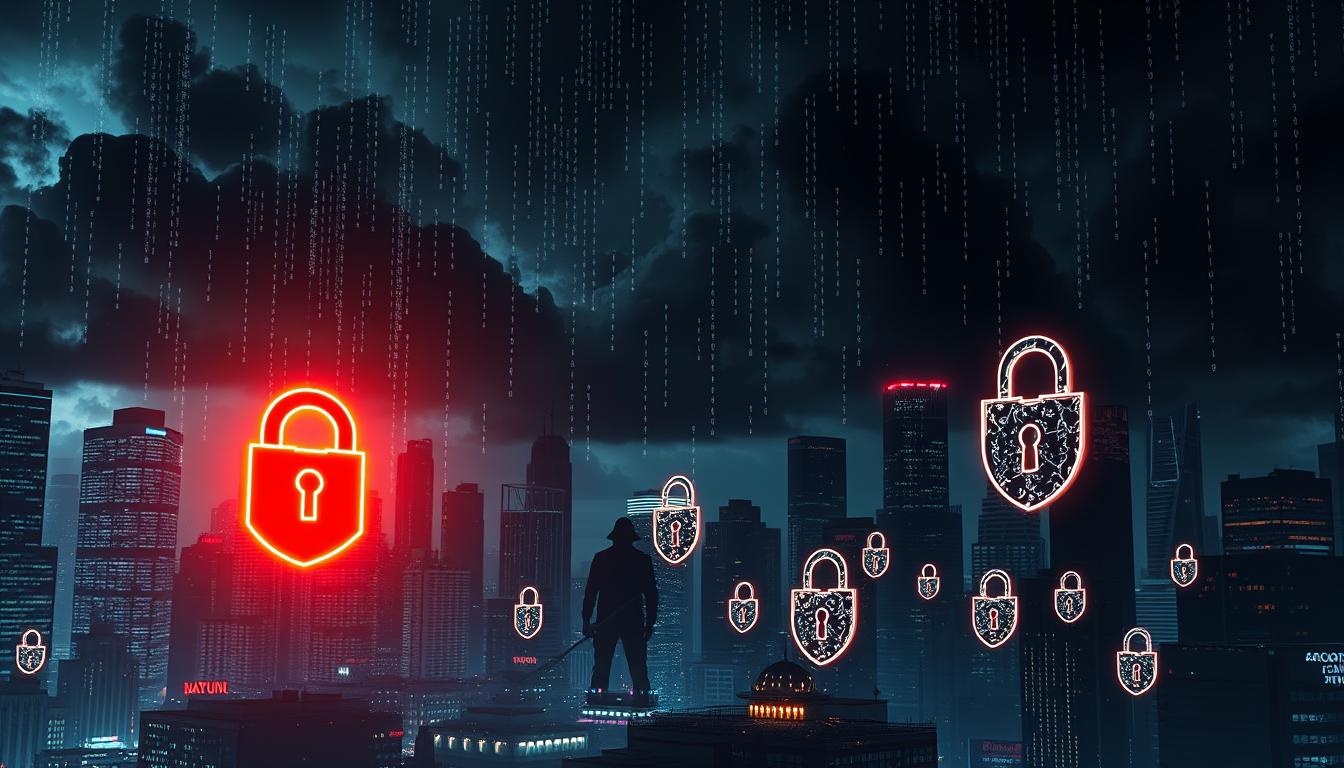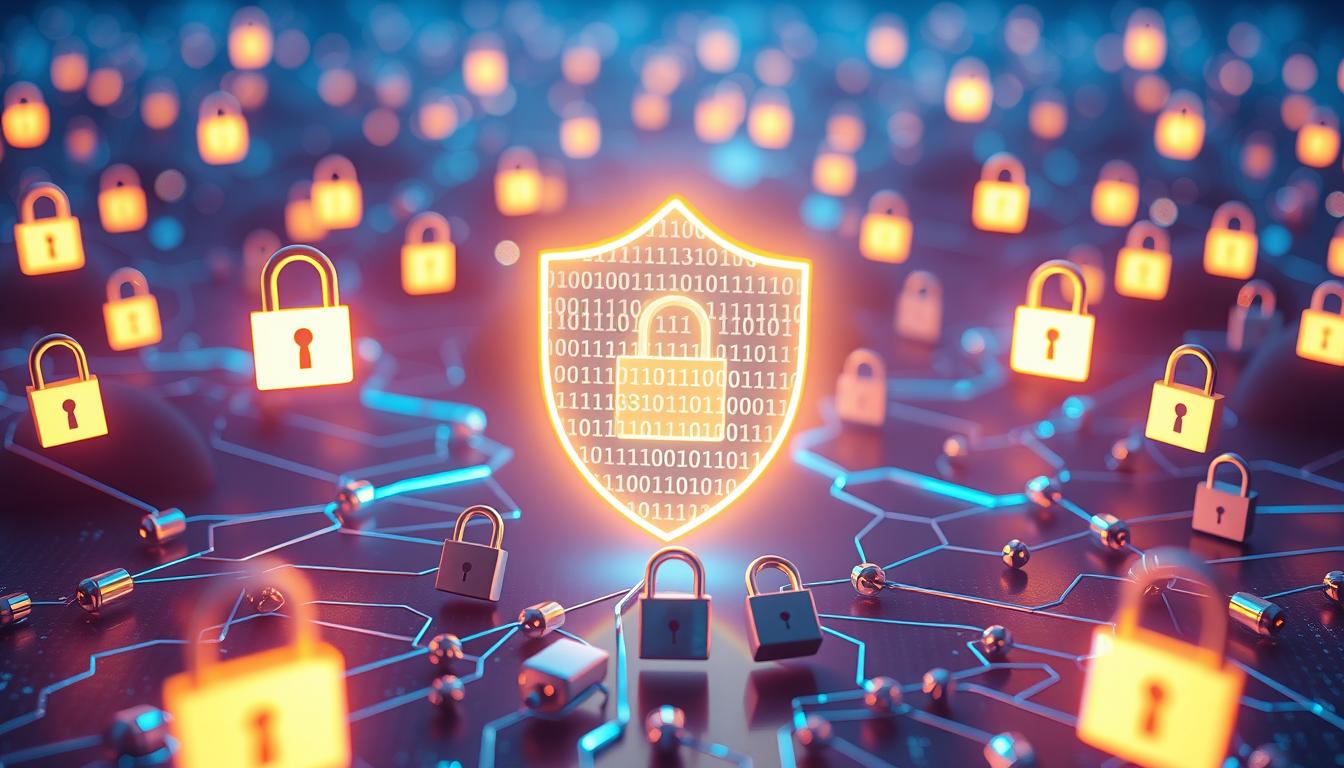In the ever-evolving digital landscape, safeguarding your online presence has become a crucial priority. Cyber threats, such as hacking, malware, data breaches, and phishing scams, can have devastating consequences, compromising your personal information, financial security, and digital assets. As we increasingly rely on technology to navigate our daily lives, it’s essential to understand the landscape of cyber threats and fortify your online security defences.
Key Takeaways
- Understand the different types of cyber threats, including ransomware, DDoS attacks, social engineering, and advanced persistent threats (APTs).
- Learn how to protect your digital assets and personal information from the impact of cyber attacks.
- Discover best practices for maintaining strong cybersecurity hygiene, such as keeping software and systems updated and creating robust passwords.
- Identify and avoid common tactics used by cybercriminals, like phishing scams and zero-day exploits.
- Implement effective cybersecurity policies in the workplace to safeguard your organization from cyber threats.
Understanding the Landscape of Cyber Threats
In the digital age, individuals and organizations alike face a diverse array of cyber threats that can have far-reaching consequences. From malicious software, known as malware, to data breaches that expose sensitive information, the cybersecurity landscape is fraught with potential danger. Understanding the types of cyber threats and their impact is crucial for safeguarding our digital world.
Types of Cyber Threats
Cyber threats come in many forms, each with its own unique characteristics and methods of attack. Some of the most common include:
- Malware: Malicious software designed to infiltrate, damage, or gain unauthorized access to computer systems.
- Data Breaches: The unauthorized access and theft of sensitive data, such as personal information, financial records, or trade secrets.
- Phishing: Fraudulent attempts to obtain sensitive information, often through deceptive emails or websites.
- Ransomware: Malware that encrypts a victim’s files and demands a ransom payment for their release.
The Impact of Cyber Attacks
The consequences of cyber attacks can be severe, affecting individuals, businesses, and even entire communities. The financial impact can be substantial, with costs associated with data recovery, system downtime, and legal liabilities. Beyond the monetary toll, cyber attacks can also inflict reputational damage, eroding trust and undermining an organization’s credibility. In the most extreme cases, cyber threats can disrupt critical infrastructure and services, putting lives at risk.
| Cyber Threat | Potential Impact |
|---|---|
| Malware | System disruption, data loss, financial theft |
| Data Breaches | Identity theft, financial fraud, reputational damage |
| Phishing | Financial losses, credential theft, social engineering |
| Ransomware | Data encryption, system lockdown, financial extortion |
By understanding the diverse landscape of cyber threats and their potential impact, individuals and organizations can take proactive steps to fortify their online security defences and safeguard their digital assets.
Fortifying Your Online Security Defences
As the digital landscape continues to evolve, it’s crucial to fortify your online security defences against the ever-growing threat of cybersecurity risks. By implementing a robust set of measures, you can safeguard your digital safety and protect your valuable data from the grasp of malicious actors.
One of the cornerstones of online security is effective password management. Crafting strong, unique passwords for each of your accounts is essential. Avoid using easily guessable information like birthdays or pet names, and instead, opt for a combination of upper and lowercase letters, numbers, and special characters.
Enabling two-factor authentication (2FA) is another crucial step in fortifying your online security defences. This extra layer of security ensures that even if your password is compromised, unauthorized access to your accounts is prevented. Consider using a reliable authenticator app or SMS-based 2FA to add an extra level of protection.
Regularly updating your software and systems is also paramount in maintaining digital safety. Software developers often release updates to address known vulnerabilities and strengthen cybersecurity measures. Stay vigilant and ensure that all your devices and applications are running the latest versions to mitigate the risks posed by cyber threats.
| Strategy | Description | Benefits |
|---|---|---|
| Robust Password Management | Creating strong, unique passwords for each account | Prevents unauthorized access and protects your data |
| Two-Factor Authentication (2FA) | Enabling an additional layer of security beyond just a password | Ensures your accounts remain secure even if your password is compromised |
| Regular Software Updates | Keeping all your devices and applications up-to-date | Addresses known vulnerabilities and enhances overall cybersecurity |
By implementing these strategies, you can significantly enhance your online security defences and safeguard your digital assets against the ever-evolving threats in the cybersecurity landscape.
“Cybersecurity is not just an IT issue, it’s a business issue. It’s everyone’s responsibility to protect our digital world.”
Best Practices for Cyber Hygiene
Maintaining good cyber hygiene is essential in today’s digital landscape. By following a few simple steps, you can significantly enhance the security of your online activities and safeguard your personal information. Let’s explore some best practices to keep your software and systems updated and learn how to create strong passwords and enable two-factor authentication.
Keeping Software and Systems Updated
Software updates are crucial for addressing known vulnerabilities and mitigating cyber threats. Regularly installing the latest security patches and updates for your operating system, web browsers, and other software can help prevent cybercriminals from exploiting these weaknesses. Enabling automatic updates whenever possible can ensure your devices are always up-to-date and protected.
Creating Strong Passwords and Authentication
Strong password management is a cornerstone of effective cyber hygiene. Avoid using common, easily guessable passwords and instead opt for long, complex passphrases that combine uppercase and lowercase letters, numbers, and symbols. Consider using a password manager to generate and securely store your passwords. Additionally, enable two-factor authentication on your accounts whenever possible, adding an extra layer of security to your online access.
| Best Practices for Cyber Hygiene | Description |
|---|---|
| Software Updates | Regularly install the latest security patches and updates to address known vulnerabilities and mitigate cyber threats. |
| Strong Passwords | Use long, complex passphrases that combine uppercase and lowercase letters, numbers, and symbols. |
| Two-Factor Authentication | Enable an additional layer of security for your online accounts by using two-factor authentication. |
“Cyber hygiene is the foundation for a secure digital life. By keeping your software updated and using strong authentication methods, you can significantly reduce the risk of falling victim to cyber attacks.”
Safeguarding Your Personal Information
In today’s digital landscape, protecting your personal data has never been more crucial. Cyber criminals are constantly devising new tactics to infiltrate our online lives, and phishing scams have become a primary tool in their arsenal. By understanding the common signs of these deceptive practices and adopting proactive measures, you can safeguard your sensitive information and maintain your online privacy.
Identifying and Avoiding Phishing Scams
Phishing attacks often rely on social engineering techniques to trick you into revealing your personal data. These scams can take various forms, from fraudulent emails and text messages to fake websites mimicking legitimate sources. To protect yourself, be cautious of any unsolicited requests for your login credentials, financial information, or other sensitive data. Verify the authenticity of the sender or website before providing any information.
Stay vigilant for these common signs of a phishing attempt:
- Urgency or a sense of emergency to elicit a quick response
- Requests for personal or financial information, even from seemingly trusted sources
- Spelling and grammar errors, or a tone that doesn’t match the supposed sender
- Suspicious-looking email addresses or website URLs
By cultivating a habit of scrutinizing online interactions and verifying the legitimacy of any requests, you can significantly reduce your risk of falling victim to phishing and protect your personal data protection.
| Phishing Tactic | Description | Potential Impact |
|---|---|---|
| Malicious Links | Fraudulent links that redirect to fake websites designed to steal your information | Loss of personal data, identity theft, financial fraud |
| Impersonation | Scammers posing as legitimate organizations or individuals to gain your trust | Compromise of accounts, unauthorized access to sensitive information |
| Emotional Manipulation | Exploiting your emotions, such as fear or a sense of urgency, to pressure you into taking action | Impulsive decision-making leading to data breaches and financial losses |
By understanding the common tactics used by cyber criminals and staying vigilant, you can take proactive steps to protect your personal data protection and maintain your online privacy. Remember, the key to safeguarding your digital world lies in your ability to recognise and avoid phishing attempts.
Cyber Threats in the Workplace
Cybersecurity is a crucial concern for businesses of all sizes, as the workplace is no longer immune to the growing threat of cyber attacks. With sensitive data, critical systems, and valuable intellectual property at stake, organizations must take proactive steps to safeguard their digital assets and protect their employees.
Implementing Cybersecurity Policies
Establishing comprehensive cybersecurity policies is the foundation for mitigating cyber threats in the workplace. These policies should outline clear guidelines and procedures for employees to follow, ensuring they understand their roles and responsibilities in maintaining a secure digital environment.
- Define access controls and data management protocols
- Implement robust password and multi-factor authentication requirements
- Regularly review and update the organization’s cybersecurity policies
Regular employee training is essential for the effective implementation of these policies. Educating your workforce on best practices, such as recognizing and responding to phishing attempts, can significantly reduce the risk of successful cyber attacks.
In addition to proactive measures, organizations must also have a well-designed incident response plan in place. This plan should outline the steps to be taken in the event of a cyber incident, ensuring a swift and coordinated response to minimize the impact and facilitate a timely recovery.
“Cybersecurity is a shared responsibility, and it’s crucial that every employee understands their role in protecting the organization’s digital assets.”
By implementing robust cybersecurity policies, providing comprehensive employee training, and developing a robust incident response plan, businesses can effectively navigate the evolving cyber threat landscape and safeguard their operations.
Staying Vigilant Against Cyber Threats
In the ever-evolving digital landscape, cybersecurity awareness is paramount. As cyber threats continue to adapt and grow more sophisticated, it’s crucial to maintain a proactive and adaptable approach to safeguarding your digital assets. Effective risk mitigation and continuous cyber threat monitoring are essential steps in ensuring your online safety.
To stay vigilant against cyber threats, consider the following strategies:
- Regularly review and update your cybersecurity protocols. Ensure that your software, systems, and security measures are always up-to-date to address the latest vulnerabilities.
- Stay informed about emerging cyber threats. Subscribe to reputable cybersecurity newsletters, follow industry experts, and participate in online forums to stay ahead of the curve.
- Implement robust incident response and recovery plans. Be prepared to respond quickly and effectively to any security incidents, minimizing the impact and facilitating a swift return to normal operations.
- Educate your employees, family, and community about cybersecurity best practices. Empower them with the knowledge and skills to recognize and mitigate potential threats.
By adopting a proactive and vigilant approach, you can enhance your cybersecurity awareness, effectively mitigate risks, and continuously monitor for cyber threats. Remember, cybersecurity is an ongoing journey, and staying informed, adaptable, and prepared is the key to protecting your digital world.

“Cybersecurity is not a one-time fix – it’s a continuous process of adaptation and vigilance.”
Conclusion
In conclusion, this comprehensive guide has armed you with the knowledge and tools to safeguard your digital world from cyber threats. By understanding the complex threat landscape, fortifying your online security defences, and adopting best practices for cyber hygiene, you can significantly reduce the risks posed by malicious actors and protect your personal and professional digital assets.
Remaining vigilant and continuously adapting your cybersecurity measures is essential to navigating the ever-evolving digital landscape with confidence. Staying informed about the latest cyber threats, implementing robust online security protocols, and fostering a culture of digital safety within your organisation are crucial steps towards ensuring your long-term cybersecurity best practices.
As the digital world continues to expand, the importance of proactive and comprehensive cybersecurity measures cannot be overstated. By embracing the strategies and recommendations outlined in this guide, you can take control of your digital destiny and navigate the online world with confidence, knowing that your most valuable data and assets are secure.



